Written by Dr Ray SH Ng (General Practitioner with interest in Sports and Exercise Medicine)
- How can I keep fit at home with the gyms closed?
- How do I start exercising again after a long lay off?
- What can I do for exercise when I am too busy?
Whilst more of us are working from home or unable to access the gym, I have been thinking about what is the best way for our patients and the wider community in Hong Kong to stay physically active. There are plenty of sources telling you what type of exercises you should be doing and I will explain what is the scientific basis behind this and what you are trying to achieve with all the effort you are putting in.
This week, I will talk about what you can do as a Beginner if you have not done much exercise (i.e. not worked out properly for the past 2 months and may be deconditioned).
This is in the form of High Intensity Interval Training (HIIT) which builds up your muscle capacity or skeletal fibers through a combination of both aerobic (requiring oxygen) and anaerobic (without oxygen) metabolism.
It is important to do activities that you enjoy so you can maintain motivation. Remember it is not duration that is important but the frequency and consistency.
So exercising intensely 15 mins per day for 5 days per week is more effective than doing 60 mins on a Sunday for instance.
Most of the activities mentioned here are not new but they should serve as the core exercise for anyone who wants to stay fit. Your main objectives are:
- Cardiovascular fitness
- Maintaining or growing muscle mass (i.e. Resistance training)
This involves working on the largest muscles in the body:
- Pectorals (Chest)
- Quadriceps (Front thigh)
- Glutes (Buttocks)
Energy Systems
To put into simplistic terms, the first two minutes of intense exercise involves 2 main energy systems which depend on the fast release of carbohydrates and an anaerobic form of metabolism called Glycolysis. During this period, lactic acid is produced.
After 2 minutes and onwards, a 3rd energy system is employed which allows the muscle mitochondria to break down the stored sugar in the form of glycogen and Free Fatty Acids (FFA) via a process called oxidative phosphorylation to release the ATP (energy) that your muscles need for contraction.
HIIT (High Intensity Interval Training)
It is best to have a combination of both Cardiovascular and Resistance/Weight training. Resistance does not mean needing very heavy weights.
This can be in the form of resistance bands, using a 500ml bottle of water in each hand, a 10 lb medicine ball or even using your body weight.
HIIT is a good starting point as it provides a good metabolic work out without using too much time – it has a high Calorie burn to time ratio.
HIIT has been found to provide physiological health benefits 1:
- Improve blood pressure
- Reduce waist circumference
- Reduce body fat percentage
As well as 2
- Improved VO 2 max (a standard measure of physical fitness)
- Increase in HDLs – High Density Lipoproteins or the Good cholesterol which protects against heart disease
There are two main types of skeletal muscle in our bodies - the Type 1 (slow twitch) which is responsible for the low intensity and long duration type of exercise (i.e. long distance running) and the Type 2 (fast twitch) which is the intense short term heavy work out exercise. Our muscles have different combinations of the two.
The premise is to keep pushing your metabolism through a duration of between 10 to 20 mins and this needs to be intense (i.e. you can just about talk but cannot sing).
This may be performed in a living room or small office space - you just need a yoga mat and a floor area of 180cm x 100cm
Aim to reach a target heart rate according to this rough formula:
220 – Age = Maximum Heart Rate.
For someone who is starting out, it is better to aim for 60 to 75% for the first two weeks of training.
But to achieve real health benefits which you would derive from HIIT – the heart rate you reach should be between 85 to 95% of the maximum. For someone aged 45,
i.e. 220 – 45 = 175 bpm
then 85 – 95% of 175 = 149 to 166bpm
I have arranged this so you are trying to alternate between working on the upper and lower parts of your body so you get a full body work out. If you find one cycle too easy, you can repeat the cycle another two times. One cycle should last around 8 mins.
If you have not been exercising much, you should start off doing this three times per week on non consecutive days for the first 2 weeks. Once you get fitter, ideally you want to aim for 5 times per week.
Please note that this is a basic regime – to get greater health benefits, requires a more vigorous work out which will be discussed in a future article.
Basic:
- Jumping Jacks: 30 seconds
Rest 15 seconds - Push up – on knees – 10 reps for 30 seconds
Rest 15 seconds - Running on spot: 30 seconds
Rest 15 seconds - Mountain climbs: 30 seconds
Rest 15 seconds - Bicycles: 30 seconds
Rest 15 seconds - Skipping: 30 seconds
Rest 15 seconds - Striking: 30s
Rest 15 seconds - Lunges: 30s
Rest 15 seconds - Plank: 30s
Rest 15 seconds - Squats 30s – 15 reps
- Shoulders and Lower limb muscles: Starting with arms on the sides of body and feet together. Raise the arms above the head til they meet. At the same time jump out so the legs are apart just wider than the hips like you are forming a “star”. Then return to the starting position. (See Diagram).
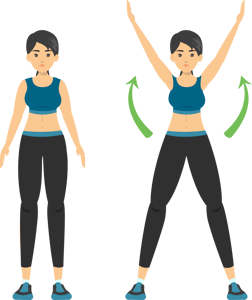
- Arms, core and legs are activated when push ups are done properly. Start in the classic push up position with the arms straight and knees bent on the floor. Keep the head, back and hips in line. Bend the arms to right angles and then extend back them up straight (See Photo).
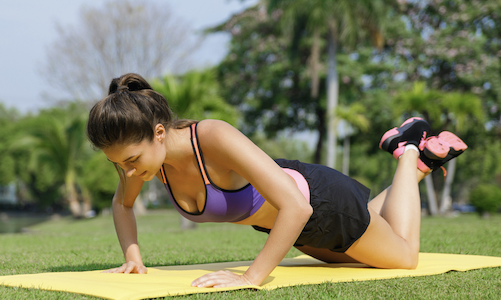
- Thigh and calf muscles: With the arms bent at 90 deg and the hands held facing down at the level of your waist, lift the legs right up to tap the knees against the palms of your hands and go as fast as possible.
- Shoulders, Core and Legs: Get into the push up position with legs straight. Whilst alternating the legs, bend one leg up towards the abdomen, then straighten with other leg bent up. Pretend you are climbing up a “horizontal mountain.” (See Diagram)
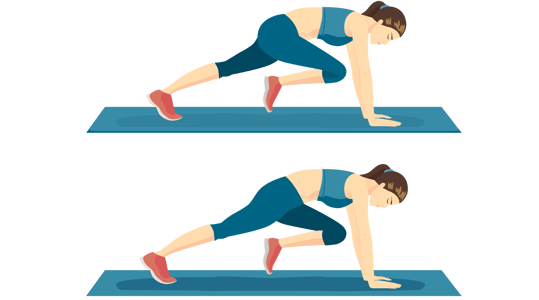
- Abdomen and Core exercise: Lie on back with legs straight. Hands resting behind the head - with tips of fingers just touching. Bend left leg at the knee and raise towards the elbow of the right arm. Then go back to default position and do the same with right leg and left elbow (See Diagram).
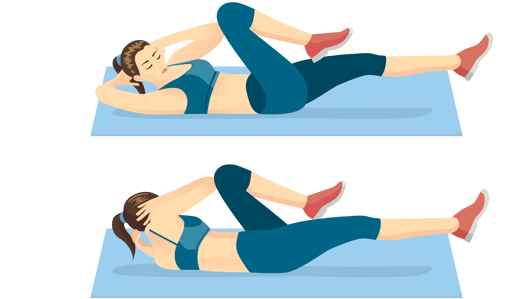
- Calf and forearm muscles: No need for rope. Feet together and knees straight. Bounce up and down on the calves whilst moving the arms as if holding a jump rope.
- Arms, shoulders and pectoral muscles: Get into boxing stance and extend one arm out then flex back and alternate with the other arm. Try to do this as quickly as possible.
- Gluteal muscles: Bend left leg at the knee to 90 degree whilst keeping the right leg behind bent, then return to standing position and repeat with the other leg (See Diagram).
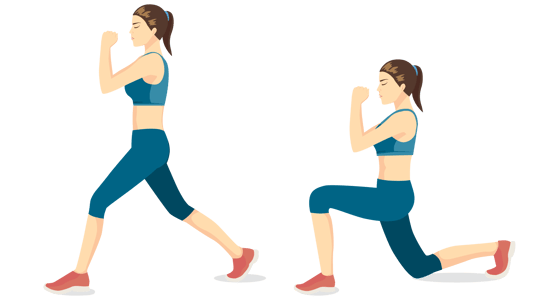
- Core, Arms, Shoulder and Legs: Facing the floor in a push up position, put both elbows on the floor with the fists pointing forward. Keep head, back and hips in line and hold position. Try to hold the abdominal muscles in for the 30 seconds duration (See Diagram).
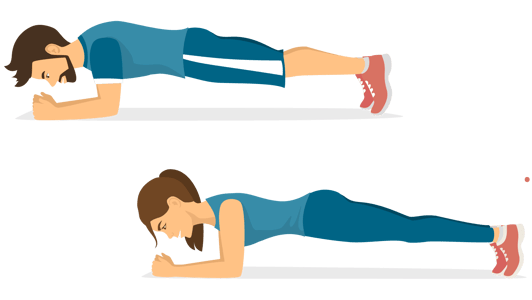
- Quadriceps and Core: To start in standing position then lower down until the thighs are parallel to the floor. If you can go lower, then do so. Raise back up to standing position (See photo).
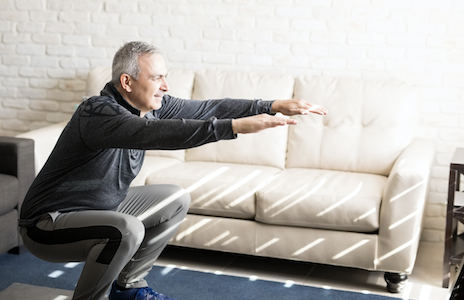
If you have:
- History of high blood pressure which has not been reviewed by a doctor
- Left sided chest pain or the feeling of a weight on the left side of the chest with exertion
- Difficulty breathing with exertion
- Poorly controlled Diabetes
- Abnormal heart palpitations
- Recent heart attack in the past 4 weeks
- Recent heart bypass surgery or stent procedure in the past 12 months
Please consult a doctor first before you start doing this type of intense exercise.
Learn more about the COVID-19 public health measures and how they work
References
- Batacan RB, Duncan MJ, Dalbo VJ, et al. Effects of high-intensity interval training on cardiometabolic health: a systematic review and meta-analysis of intervention studies. British Journal of Sports Medicine 2017;51:494-503.
- Weston KS, Wisløff U, Coombes JS. High-intensity interval training in patients with lifestyle-induced cardiometabolic disease: a systematic review and meta-analysis. British Journal of Sports Medicine 2014;48:1227-1234.

 Central General Practice
Central General Practice
 Repulse Bay
Repulse Bay
 Clearwater Bay
Clearwater Bay
 BodyWorX Clinic
BodyWorX Clinic
 Central Specialist Clinic
Central Specialist Clinic
 MindWorX Clinic
MindWorX Clinic
 Partner Clinics
Partner Clinics
 Family Clinic
Family Clinic
 OT&P Annerly Midwifes Clinic
OT&P Annerly Midwifes Clinic

